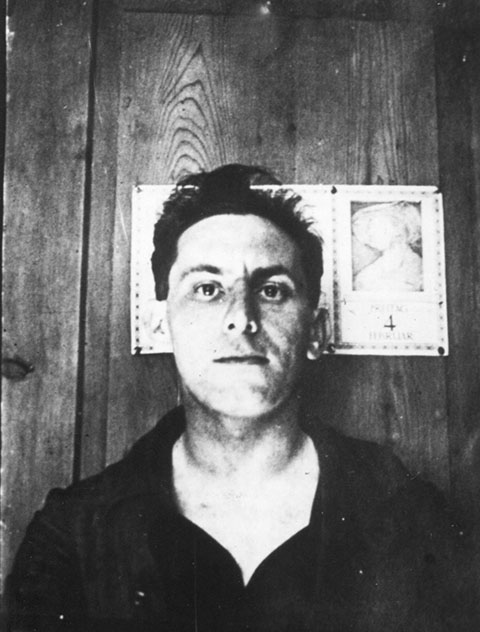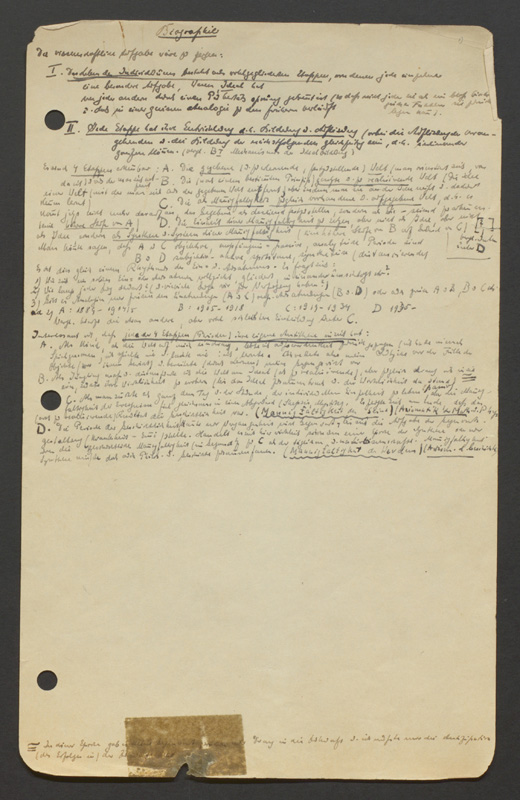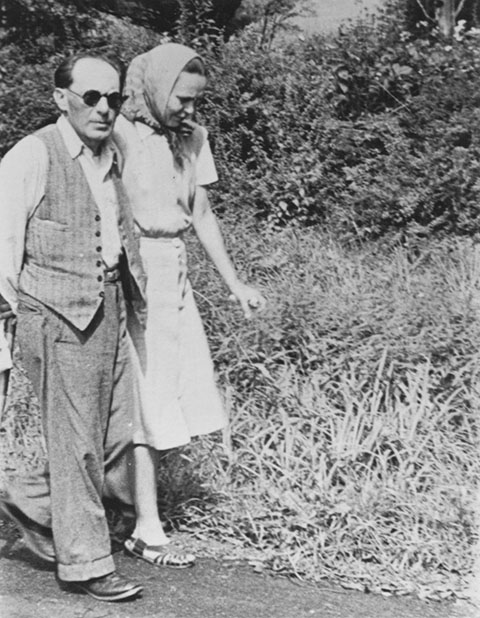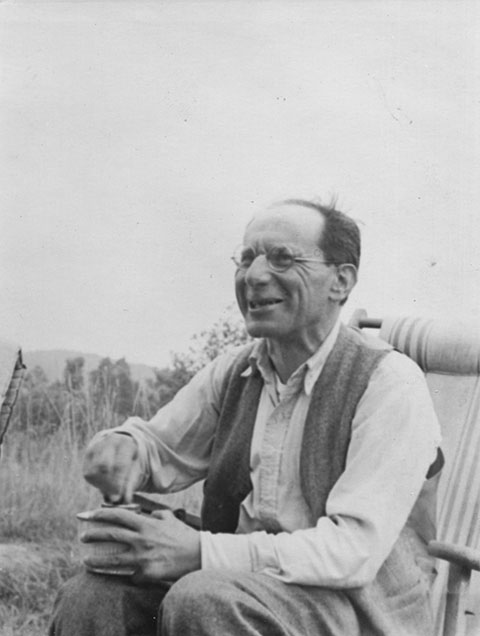Biography¶
The point of departure for this research project is the article 'Der Expressionismus' published by Raphael in September 1911, which was aimed at identifying the contemporary tendencies in art.
In the period from 1910-1913, Raphael effectively created not only the term 'Expressionism', but also developed what was to become the basic historical reading of modernity, especially culminating in his work Von Monet zu Picasso, published in Munich in 1913.

With 'Der Expressionismus' Raphael was the first to name and provide a theory of Expressionism in the German language. His writings in these years are also the fruits of the first period of his lifelong engagement with art, and his many-sided research to provide 'an empirical theory of art', which would continue until his death by suicide in New York in 1952.
Some of this research was published subsequently by the Bollingen Press. In a note Raphael sent to the Bollingen Foundation we have perhaps the most succinct description of his life's work:
The work I have been doing for the past 35 years concerns a theory of art encompassing:
- the essential concepts of a scientific description of a work of art
- a theory of art criticism, and
- a theory of art history.
All my published work since 1913 and all my unpublished studies have been preparatory work for this purpose. They covered, from the historical and aesthetically point of view, modern art (architecture, painting, sculpture) of the XIX and XX centuries, the architecture and sculpture of the XII century, Greek architecture, the paintings of the Palaeolithic caves in France and Spain, and the prehistoric pottery of Egypt. My theory of art shall be general, i.e. valid for all times and all peoples. Therefore I had to analyse the creative process of the human mind, a project which was realised in my book Theory of Knowledge. Moreover history of art cannot be separated from economics, sociology, politics, religion etc., thus my studies embraced these fields too.
The work 'Theory of Knowledge' to which Raphael refers in the letter was published in German in 1934, under the title Zur Erkenntnistheorie der konkreten Dialektik, and in 1938 in French as La théorie marxiste de la connaissance (NRF, Gallimard). Returning to consider the first part of these studies, which were issued in various publications from 1910, sometimes under the pseudonym Schönlank, or Schönlanke (after his place of birth, in Western Prussia, where he lived until the age of 10), we can see between the work on Expressionism and the book-length publication Von Monet zu Picasso the setting out of his research to explore a theory of creativity and engage in contemporary criticism, which put him at odds with the established practice of art history as promulgated by Wölfflin in his Principles of Art History. Notably, Wöllfflin had refused to accept Raphael's proposal for a thesis on Picasso, telling him: 'Such a topic is of no interest to me'.
In a memoir on Raphael, Professor Claude Schaefer has suggested that in Berlin the young student had been noticed by Simmel, who is said to have told Raphael: 'Since you are such an independent spirit, there is nothing much for you in the university.'
In his 'autobiography', Raphael noted 1910 was a year of wandering along the Rhine, the significant meeting with Max Pechstein, whose sketch portrait of Raphael survives, and most significantly of all - as he tells in one of his published articles - of the shock of seeing a painting by Picasso in a window in Paris, which in retrospect would be a fatidic moment for his whole life.

Nürnberg, Germanisches Nationalmuseum, Deutsches Kunstarchiv, NL Raphael, Max, I,B-13 (0001)
View high resolution version on this page
When reviewing works of Seligman in the early 1950s, Raphael would return to the artists who inspired some of his deepest reflection and trenchant criticism: Picasso, Cézanne and Matisse. John Berger decicated his famous work The Success and Failure of Picasso to Max Raphael, 'a forgotten but great critic', and Herbert Read ranked him as the most significant theorist of art of the first half of the 20th century. Read was instrumental in having Raphael's essays published in English tranlation by Norbert Guterman by the Bollingen Foundation, under the title The Demands of Art, where we have the most advanced example of his theory at work.
The immediate context of the article 'Der Expressionismus' was Raphael's confrontation with the writing of Lovis Corinth who, in the journal Pan, had dubbed the young, modern artists 'a horde of imitators':
In the thirteenth issue of Pan, mister Lovis Corinth has, under the title of 'The Latest Painting', published a study in which he seeks to write off young artists as a horde of imitators. They imitate Cézanne (about whom mister Corinth writes as academically as one should about him), van Gogh and Gauguin. They copy 'the present-day pictures of Negroes and Malayans, the painting on Indian tepees'. In short 'the young forget that no master has ever fallen from the sky and that everything great has come into being through taking pains, through work, and learning. They begin - as Liebermann rightly says - where the great masters have left off'.
Raphael then proceeds to sharply rebuke Corinth, making the point that he repeats what had once been said about him, and that the comparative judgement he draws is misplaced:
Behind these truisms is concealed the usual accusation of inability that is levelled at every new phenomenon.
Raphael suggests that he will break the bad habit that tries 'by every means to avoid naming names', and in a direct rebuttal to Corinth suggests that he will name the future of painting and artists who concentrate their creative will in a totally new way, and:
much more intensely than mister Corinth ever has. Of the foreigners we have Matisse and Picasso, de Vlaminck and Kees van Dongen. Among the Germans, Pechstein and Purrmann, Erbslöh and Levy, Kirchner, Heckel and Schmidt-Rottluff. There are certainly a few names missing, but I assume gladly and joyfully that none of them has ever visited mister Corinth's academy.
The polemic shifts from making jibes at Corinth to an analysis of Impressionism and its different goals, to what he identifies as the 'new art': 'In Impressionism, the world as human representation seems not only to be drawn into the uncertainty of movement, but this representation is itself also dissolved in an eternally flowing play of elements.'
What this suggests to Raphael is not only the oneiric nature of Impressionism, but also that it was not founded on representation, 'if one understands this to be the joining of several impressions into a clear picture in the memory', but on perception. He adds that this is probably the case of every naturalism: 'This new kind of perception was brought into being by the artist's devotion to nature, his empathy with cosmic life.'
Raphael sums up his trenchant critique of Impressionism by declaring the distinguishing tendencies he sees in the new movement:
If I had to distinguish the tendencies of the Expressionists from those of their predecessors, I would say: [...] The Expressionists mistrust the impression - immediate, multifarious in its chance nature -, and seek to raise it to an unambiguous, clear, simple and necessary concept. Their work is based on abstraction [...] [They] form this perception into closed pictures.
Speaking of the response to non-European art, Raphael notes that the Expressionists had an 'eminent ability to re-experience those simple and expressive forms. For the artist, they are the adequate form of his imaginative content and not pure copies.'
The text ends with a return to Corinth and a ringing declamation:
We, friends of the new art, can do without the kitsch painters Manguin and Friesz, the adulterators of our ideals [...] We want to see: Matisse and Picasso, de Vlaminck and Kees van Dongen, Pechstein and Purrmann, Erbslöh and Levy, Kirchner and Heckel, Schmidt-Rotluff.
It is fascinating to chart Raphael's research over a period of three years, in more than sixteen published articles, and its culmination in the work Von Monet zu Picasso. In 1910, and 1912 he had made visits to Paris, met with Rodin, Matisse and Picasso, and studied the work of Poussin and medieval architecture. Raphael was certainly influenced by Bergson and Simmel in his early formulation of a theory of artistic creation, and he directly challenged the dominant neo-Kantian aesthetic which was so much part and parcel of German academic life. He undertook intensive studies of Husserl, engaged in research on mathematics, wrote plays and took himself to Bodensee, where he stayed at Überlingen and was, as Schaefer notes, surprised by the outbreak of World War I. His studies were aimed at resolving the theoretical questions in the first part of Von Monet zu Picasso: how does one find from the genesis of a work its raison d'être?
In the course of his military service he developed arguments for conscientious objection in a diary entry titled 'Geist wieder Macht', and wrote a long work on Kant's Perpetual Peace. (The first volume of the Suhrkamp Werkausgabe, 1989, entitled Lebens-Erinnerungen has excerpts from diaries at this date, and valuable extracts from correspondence.) He deserted the army and went to Switzerland in 1917, remaining there until 1920. During this time he met with individual artists, for example de Fiori (de Vogelaer), Haller, von Tscharner, Wiegele, and published articles on their work.
In his 'autobiography', a document of less than 25 closely written pages probably composed in 1951, Raphael acknowledges that he was no longer able to maintain his earlier theoretical position, and saw that his idea of theory rested on a metaphysics which could only be hostile to the empirical world. His turn was toward a new question, namely the question of the State and social order.
From Switzerland he relocated to Berlin in 1920, and offered various projects for publication, of which Idee und Gestalt was accepted, a work whose metaphysical assumptions he was concurrently beginning to deconstruct. Claude Schaefer sees 1920 as a date at which the direction of Raphael's interest begins to sharpen and his analysis takes a turn to concreteness. This involved him in the study of the exact sciences and mathematics, with work pursued on Newton's axioms, and exhaustive investigations on particular works of art. In some sense his paper on the tropes of scepticism ('Die pyrronischen Skepsis', published in 1921) marks the collapse of Raphael's 'idealist commitments', a turning to the exact sciences, and increasingly studies which went in the direction of Marx.
Significant for Raphael in the midst of these severe concentrated studies was the contact he established with the Volkshochschule Gross-Berlin, where he taught from 1924. In some way this was an experimental station where he could check the effectiveness of the working method he was developing. He gave seminars on Plato, Aristotle, Aquinas, on Husserl's Logical Investigations and the work of Max Scheler, and on dialectic method in Marx and Hegel.
He also taught at the Marxistische Arbeiterhochschule von Gross-Berlin. Schaefer suggests that the director, J.L. Schmidt, made Lukács aware of Raphael's writing on 'a Marxist theory of art'. Raphael viewed his teaching, retrospectively, as leading him via practice and experience towards the political and its impact on the exact sciences. The breadth and extent of Raphael's work in this period is simply astonishing. From monograph-length studies on Corot, on Rembrandt, on Degas - essays which were to appear translated in edited version in The Demands of Art, which also contains a later account of Raphael's 'Empirical Theory of Art'. Some of this period required rest at sanatoria in Davos or Arosa, where he also gave lectures. Raphael extended his methodological work to literature, studying the writing of Valéry, and continued with his architectural analysis, publishing his work on the Doric temple, which involved him re-measuring temples in Sicily, in 1930. He was also responding in detail to the competition for the Palace of the Soviets, and attedempting to formulate a theory of 'democratic architecture'.
In 1932 Raphael proposed to the directors of the Volkshochschule a course on the scientific foundations of Marx's Capital, and a course on the sociology of art. The directors cautioned prudence, given the political situation in Germany, and Raphael took the decision to leave the school, and Germany and go to Paris, where he arrived on the 1st of December 1932 and would remain until the first half of 1941. Raphael never joined any political party.
It was the works published from these studies in the 1930s that Bordieu claims were of considerable import for his theoretical development. Nishida in Japan also noted the value of Raphael's writing, and there is clear evidence that Walter Benjamin was profoundly influenced in his understanding of 'a Marxist theory of art' by his reading of Raphael, whom he cites in the Passagen-Werk.
Raphael began to publish in French immediately. The éditions Excelsior published his Proudhon Marx Picasso. Trois études sur la sociologie de l'art in 1933. The same year his book on the school of Lurcat in Villejuif appeared (J-L Cohen dedicated a thesis study to this work), as well as articles on Picasso in Minotaure . In 1934 the 'Marxist Theory of Knowledge' Zur Kunsttheorie des dialektischen Materialismus was published in Paris and smuggled into Germany; it would be issued in a French translation by Gallimard in 1938. Raphael had taken up contact with Löwenthal and Horkheimer at the Institute in regard to this work. In 1935 he wrote a monographic study on Romanesque church architecture in France after prolonged study visits to the South of France. These studies were much appreciated by Meyer Schapiro, who arranged to have some of Raphael's writing published in the Marxist Quartely in New York. In 1936, Raphael prepared a study on Flaubert, which was followed by a long manuscript on Racine in 1939. This year, 1939, also saw the production of his text Arbeiter, Kunst und Künstler (Workers, Art, and Artists), which could be viewed as a synthesis of the preceding research of the decade, the 1930s. First delivered as a series of lectures to Swiss workers, and based also on his lectures in the Louvre, it is the fullest explication of his method, especially in the analysis of a work of Corot, to which he dedicated a minute analysis. (He would send this to the Institute for Social Research, and Horkheimer considered publishing an extract. Some of the correspondence indicates that Horkheimer was personally very impressed with the serious purpose of Raphael, and remarked in correspondence on his shyness, and scholarly competence.)
The analysis should be supplemented by his text on 'An Empirical Theory of Art', composed at the beginning of the 1940s but not finally elaborated until 1945. Raphael provided his own assessment of these works as constituting the first part of his projected 'theory of art; and the fundamental notions of description'. He was still unsatisfied with what he had set out, and wished to enlarge the historical understanding to which he had arrived. He hoped to return to study the last painting of Poussin, the unfinished Apollo and Daphne. It was when lecturing in front of this work in the Louvre that he met a young woman from Germany, Emma, who was to be his future wife.
Raphael was placed in an internment camp in the South of France, where he continued to compose, writing texts on a Marxist ethics and Spinoza. Diaries survive of this internment experience, from Emma, which make for harrowing reading.
He left France aided by the Quaker Mission and arrived in New York on 22nd of June 1941, where he was later joined by Emma, who took cleaning jobs in the city to support their precarious existence.

Raphael wrote his account of the last days he spent in France as a preface to his (unpublished) history of German industrial capitalism. From a letter he wrote to Claude Schaefer on the 14th of November 1943, one can grasp the direction of his work at this date, and the extreme conditions under which it was carried out. A similar letter to Alice Guggenheim has been published in the Lebens-Erinnerungen. (Neither Löwenthal, nor Horkheimer could, due to straitened circumstances of the Institute, help with either publication or financial assistance. Meyer Schapiro was also unable to provide assistance in New York.)
The letter gives an account of Raphael's work from the time of arrival in New York. He had begun to study the Neolithic Egyptian pottery in the Metropolitan Museum in New York, and attempted to interpret from the changing forms of the pottery the changing conditions of the economy and of the society. In the ornamentation he saw magical signs with a precise meaning, and he succeeded in translating these signs into contemporary abstract language, which antedates the use of hieroglyphs by 1.000 to 1.200 years. In seeking to understand the causes for these transformations Raphael focused on the significance of social transformation, economical and political. These studies led him to consider the diachronic relations of art, and not just the synchronic relations between an infra- and super-structure within the social. He wanted to see if the magic signs of the early Neolithic were related to the signs found in cave art, in the Palaeolithic caves of France and Spain especially. The second question he approached was: how did religion emerge from magic?
Raphael saw this process as occurring through domestication and the beginning of agriculture - influenced by the research of Gordon Childe - and proposes that the emergence of a new dominant class which no longer required the use of magic for the animal hunt, instead needed these means against other humans, and thus developed signs that are more restricted and limited in their communication; signs that were meaningful only to the initiated. To his surprise he found in measuring the Palaeolithic paintings that there was a consistent appearance of the golden section, approximately that of Paccioli, that is 2:3 = 3:5. Although surprising, he said he found a simple explanation for this: the human hand. Through spreading the fingers of the hand, one could approximate these proportions, and so the stylisation in Palaeolithic art could be better understood from the presence of the hand. It seemed to Raphael that each period of art might have such a unifying source - for example the use of Euclidean co-ordinates by the Greeks, deployed from the interior to the exterior - and that according to the emphasis on this or that solution one could distinguish the different phases of Greek art.
These researches also took him to reconsider his earlier writing on artists. His essay on Picasso's Guernica - the touchstone for Berger's The Success and Failure of Picasso - was re-written in the last year of his life, and published as part of The Demands of Art in 1968. Two other volumes on architecture and sculpture had been planned to accompany this work with the general title of 'Wie will ein Kunstwerk gesehen sein?' - 'How should a work of art be viewed?'
Raphael planned to return to Europe to study the Palaeolithic cave paintings. As his student Shirley Chesney writes in the introduction to Wiedergeburtsmagie in der Altsteinzeit (Fischer Verlag, 1979), the trip was in preparation at the beginning of 1952.
According to Professor Schaefer, Raphael fell into a depression, aggravated by difficult life constraints and a torrid New York summer, which led him to commit suicide on the 14th of July 1952.
Patrick Healy

Sources¶
- Material from the Werkausgabe (Frankfurt-am-Main: Suhrkamp, 1989).
- Claude Schaefer, typescript of the unpublished 'Memoir'.
- Unpublished manuscript of Raphael's 'autobiography'. Healy Papers, FIU, Amsterdam.
- Paper by Shirley Chesney from Hamburg, Raphael Conference, 1989.
- Patrick Healy and Hans-Jürgen Heinrichs (eds.), Das schöpferische Auge, oder, Die Geburt des Expressionismus, die frühen Schriften, 1910-1913 (Vienna: Gesellschaft für Kunst und Volksbildung, 1993).
- Patrick Healy (ed. and transl.), The Invention of Expressionism: Critical Writings 1910-1913 (Amsterdam: November Editions, 2016).